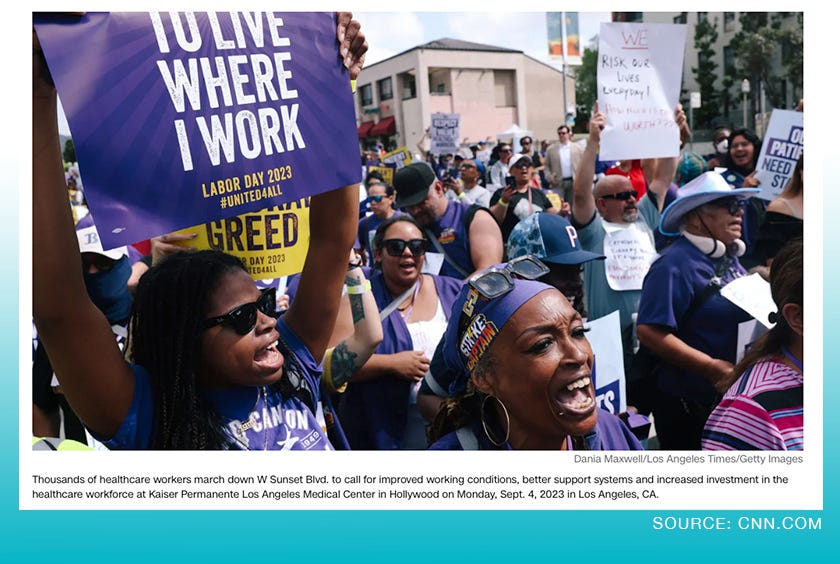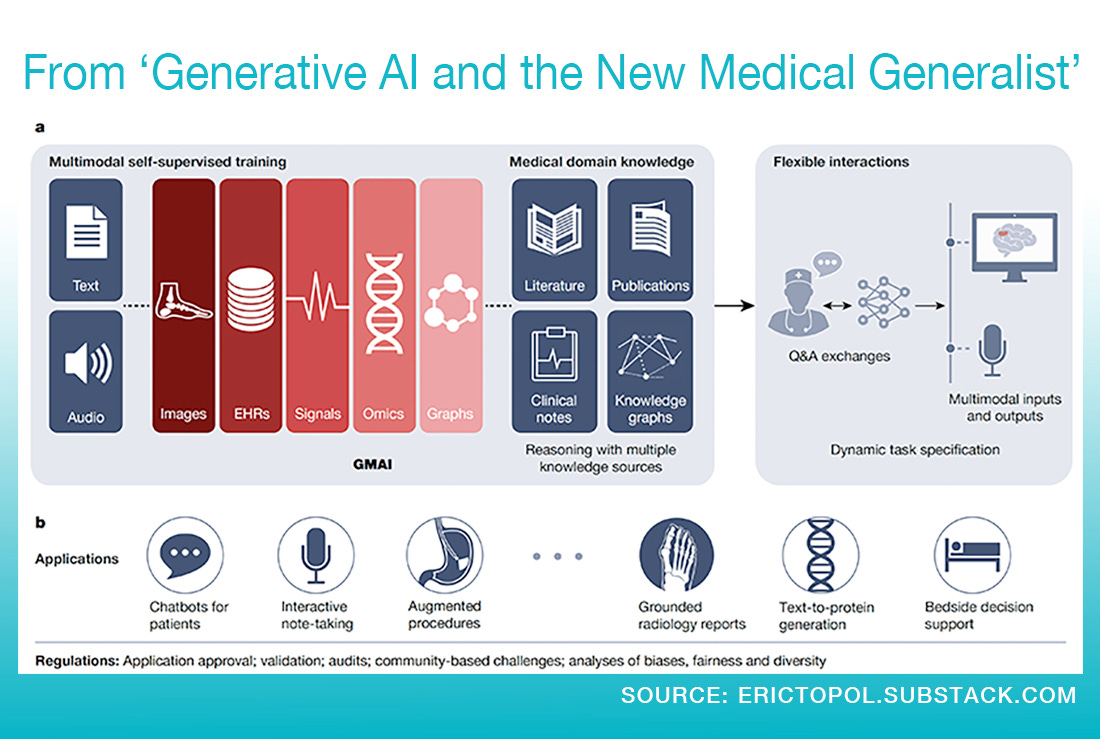Dr. ChatGPT? (not exactly, but...) | Housing as a giant carrot | Hire-then-train as the future of HC staffing
Also: The biggest healthcare strike U.S. history could happen next week
Today’s edition highlights some unique technology and hiring trends that have tons of potential for fixing staff shortages now and in the future:
Generative AI in clinical settings? It’s here.
Free housing makes a very big recruiting carrot.
Employer-paid online training is the future for solving long-term labor shortages.
How “succession planning” for healthcare employers’ leadership is as vital for workforce planning as keeping front-line teams fully staffed.
But first, a quick news update that illustrates the seriousness of the U.S. healthcare workforce crisis:
More than 75K employees at the nation’s largest not-for-profit healthcare system may be going on strike next week.
Kaiser Permanente’s patients in California, Colorado, Oregon, Washington, Virginia, and D.C. will almost certainly be impacted if a deal isn’t reached by midnight tomorrow (Sept. 30), according to news reports.
The workers threatening to strike — members of the SEIU-UHW union — represent a variety of hospital positions including nursing, EMTs, lab techs, optometrists and many other hospital support staffers, comprising about 40% of the health system’s workforce, according to CNN.
The union seeks raises to keep up with inflation and a fix for labor shortages. One emergency medicine tech from a Kaiser Permanente hospital in California said they usually have just five to seven EMTs on staff in their 85-bed emergency room, which should have a minimum of 15 on duty.
It would be the largest-ever healthcare strike in the United States, in a year that has seen more strikes than ever before — about 300 since January 1.
Meet Dr. GPT? No, but your doctor’s assistant may soon be AI-powered
Becker’s Hospital Review has a couple of fascinating new reports on health systems harnessing the power of generative AI to save time on documenting and summarizing clinical records.
Naomi Diaz writes about Beacon Health System of South Bend, Indiana, which says its artificial intelligence-powered clinical documentation tool — called Dax, from Nuance — has allowed its physicians to "improve" the number of patients they see.
Dax can “automatically create clinical summaries for review and entry into the patient’s electronic health record, and Beacon says it has proved “useful to relieving burdens for its staff,” in a new YouTube video posted by the technology’s maker.
And over in Virginia, Sentara Health is expanding an AI-powered clinical documentation tool to its 12 hospitals, according to a Becker’s report by Giles Bruce.
Sentara has been testing the technology from Regard at four hospitals since last fall; it scans data in the patient’s electronic records to “recommend diagnoses and draft notes for clinicians that they then review, edit and sign.”
FWIW: I imagine that most patients will have mixed feelings about the idea of AI recommending a diagnosis, knowing how short-on-time doctors already are.
In a perfect world, such technology could have fantastic benefits — IF hospitals and medical clinics were fully staffed, and providers had both the time and a standard for checking the AI’s work.
The concern, obviously, is that over-burdened physicians are given an AI-powered shortcut with little oversight on the AI’s accuracy or efficacy.
If we have guardrails in place? Then heck yeah, I say!
Let AI technology improve the record-keeping process and quickly search the latest peer-reviewed research to suggest diagnoses and solutions to the doctor. Lord knows no doctor on earth has time to keep up with the vast amount of medical breakthroughs that scientists and researchers publish every week. (Neuroscience and genetic science, for example. The number of discoveries happening every week in those fields alone is astounding!)
But if we don’t fix the staff shortages, and we keep piling more patients onto a doctor’s schedule? I’m not sure I am eager to see how that plays out for patients.
An MD-Scientist’s Extensive Overview of AI’s Potential in Medicine
Related: This article by physician, scientist, and author Eric Topol offers an in-depth and well-researched look at the potential for AI in healthcare. The graphic below is from Topol’s “Generative AI and the New Medical Generalist.” Super interesting stuff, and it offers some hope for an overtaxed (some might say hopeless) healthcare system.
Healthcare recruiting’s biggest carrot yet: Free housing
Alexis Kayser at Becker’s reports on a South Carolina hospital offering new employees free housing — and in Hilton Head, where housing is extremely expensive and hard to find.
“Hilton Head Regional Healthcare has entered an agreement to rent nearby loft apartments on a short-term basis, according to a Sept. 27 news release. The system is paying below area market rates and will offer the units to clinical staff who are new to the area — including travel nurses — at no out-of-pocket cost.”
FWIW: I’m not sure why it’s so very unusual for industries where hiring is crucially competitive to provide healthcare to new employees they’ve recruited to town, but it is, at least in healthcare.
With all the empty office buildings in major metro areas, and hundreds of shuttered shopping malls dotting the country, it sure seems like a good time for a program that would enable employers in critical sectors to take on renovations and offer housing for workers.
Hiring bonuses are old news; hire-then-train is the future
A recent Forbes article by Rafael Castaneda (of MedCerts, the sponsor of Healthcare Workforce Report) explains why signing bonuses are out, and a strategy that provides on-the-job training to entry-level hires and career-starters is the future of healthcare staffing.
The theory makes a lot of sense in this post-pandemic world where online training is more accessible and more varied than ever.
Highlights from the piece:
“When an organization is persistently short-staffed, hiring managers commonly feel the ‘hair-on-fire’ pressure to meet staffing goals — particularly in healthcare, where unfilled jobs can visibly impact the lives of existing staff and of patients, not to mention the bottom line.”
Focusing recruitment on work-ready candidates is short-sighted, he says, and it’s expensive, with HC employers spending millions on hiring bonuses that do nothing to grow the talent pool or fill future openings.
“Part of your strategy should be to stop competing for already trained workers and shift to strategic investments in train-and-hire models that are based on finding candidates with the aptitudes and attitudes your business needs most. … Skills and job-specific expertise can be taught; a willingness and desire to learn and grow cannot.
“With no cost to the trainee, a job during training and a better career path upon program completion, mixed with the opportunity to earn college credits toward a future degree? That’s an opportunity that candidates cannot ignore.”
Check out the full article over at Forbes. If you’re involved in healthcare recruiting or workforce development, it’s well worth 5 minutes.
Strategic planning is also necessary for HC leadership: resources from AHA
A recent Advancing Health podcast explains why healthcare employers need a solid “succession plan” — a strategy for developing and growing the next generation of leaders, and how doing so will strengthen the entire workforce. Accompanying the podcast, the American Hospital Association posted some resources and a new infographic that spells out why this is even an issue: When an organization has a persistent, long-term shortage of workers (and job candidates), the existing staff is overburdened, and that effect quickly trickles upward.
The same is true from the top down. The podcast delves into why a successful workforce strategy must include not only hiring and training plans for entry-level and middle-management roles but also “succession planning,” or actionable steps for developing strong leaders and ensuring smooth transitions in top-level roles, too.
Shout-out to Healthcare Workforce Report sponsors
The Healthcare Workforce Report newsletter is generously supported by MedCerts.
For information on supporting HWR, email HealthcareWorkforce@substack.com.







